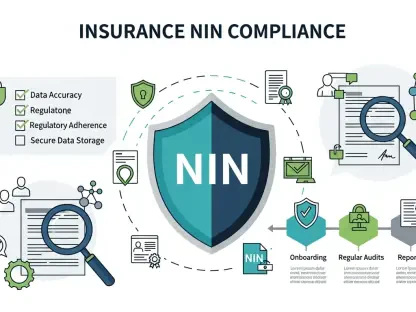The cyber insurance market finds itself at a critical juncture, wrestling with the dual challenges of maintaining affordability for policyholders and ensuring financial stability for insurers amid an ever-evolving landscape of digital threats. As artificial intelligence (AI) amplifies the sophistication and scale of cyber risks, the industry faces unprecedented pressure to adapt quickly to these technological advancements. Insights from experts like Megan North, executive vice president at Amwins Insurance Brokerage, reveal a sector caught in a delicate balancing act—striving to offer competitive pricing while grappling with rising claims and unpredictable exposures. This tension is compounded by a surge in demand for coverage as businesses awaken to the devastating potential of cyberattacks. This article explores the intricate dynamics shaping cyber insurance, from pricing dilemmas to the transformative impact of AI, shedding light on how the market is navigating these turbulent waters in search of sustainable solutions.
Navigating the Pricing and Sustainability Dilemma
The cyber insurance market is currently grappling with a significant mismatch between softened pricing and the escalating cost of claims. With rates dipping close to levels seen several years ago, businesses find themselves in a favorable position to secure coverage at more accessible costs. However, this affordability comes at a steep price for insurers, who are contending with losses that have not scaled down proportionally. The persistent imbalance sparks concern about the long-term viability of such pricing structures, with some industry observers cautioning that a sharp market correction could be on the horizon if trends continue unchecked. This scenario poses a fundamental challenge: how can insurers maintain competitive rates without compromising their financial health in an environment where cyber incidents are becoming more frequent and severe?
Beyond the immediate pricing concerns, the sustainability of the cyber insurance market hinges on finding a delicate equilibrium that benefits both insurers and policyholders. The soft market conditions have undoubtedly expanded access to coverage, yet they also raise questions about whether insurers can absorb the growing financial burden of claims over time. Historical market shifts, such as those witnessed in prior years, serve as a stark reminder of how quickly conditions can change when losses outpace premiums. For now, the industry remains in a precarious position, striving to balance short-term affordability with the need for long-term stability. Without strategic adjustments—whether through refined pricing models or enhanced risk mitigation—there’s a risk that the current environment could undermine the market’s ability to support businesses facing increasingly complex digital threats.
Rising Demand and Shifting Client Needs
A surge in demand for cyber insurance has emerged as a defining trend, driven by the alarming frequency of high-profile breaches that expose vulnerabilities across industries. These incidents not only disrupt primary targets but also ripple through interconnected networks, amplifying the urgency for robust protection. Businesses, now more aware of the catastrophic financial and reputational damage cyberattacks can inflict, are either entering the market for the first time or seeking to bolster existing policies with higher limits. This heightened interest underscores a broader recognition that cyber risks are no longer a niche concern but a critical component of enterprise risk management, pushing insurers to meet a growing and diverse set of needs in a competitive landscape.
Alongside this rising demand, client expectations are undergoing a notable transformation, reflecting a desire for more than just financial safeguards. Policyholders are increasingly receptive to value-added services offered by insurers, such as risk assessments, vendor discounts, and breach response tools. These offerings represent a shift toward proactive security measures, aiming to reduce the likelihood and impact of incidents before they occur. This evolving mindset suggests that businesses view insurance not merely as a safety net but as a partnership in strengthening their cyber defenses. Insurers, in turn, are adapting by integrating these services into their portfolios, recognizing that fostering resilience among clients can ultimately lead to fewer claims and a more stable market environment over time.
Underwriting Challenges in Vulnerable Industries
Underwriting practices in the cyber insurance market are becoming increasingly selective, particularly in sectors that have experienced substantial losses. Industries such as healthcare, manufacturing, and financial services are under intense scrutiny due to their heightened exposure to cyber incidents, often driven by sensitive data and complex operational systems. Even as overall pricing remains soft, underwriters are adopting a more conservative stance in these high-risk areas, tailoring policies to mitigate specific vulnerabilities. This targeted approach adds layers of complexity to the market, as insurers strive to manage their exposure without resorting to widespread premium hikes that could alienate clients or stifle demand.
The shift toward stricter underwriting also reflects a broader effort to align risk assessment with the realities of an evolving threat landscape. In high-loss sectors, insurers are delving deeper into the cybersecurity postures of potential policyholders, often requiring detailed evaluations before offering coverage. This meticulous process, while necessary for controlling risk, can create friction for businesses seeking quick and affordable solutions. Nevertheless, it highlights the industry’s recognition that not all risks are equal, and a one-size-fits-all approach is no longer viable. By focusing on sector-specific challenges, underwriters aim to build a more resilient market, though the challenge remains in balancing caution with accessibility to ensure that coverage remains within reach for those most in need.
Opportunities for Growth in Diverse Segments
The cyber insurance market is ripe with growth potential, particularly among small to midsize enterprises (SMEs), which are increasingly vulnerable to digital threats. As cyber incident costs rise, SMEs represent a high-volume segment with a pressing need for affordable, tailored coverage that fits their unique risk profiles. Many of these businesses lack the resources to implement robust security measures independently, making insurance a critical tool for safeguarding their operations. Insurers are seizing this opportunity by designing programs that address the specific challenges faced by smaller entities, ensuring that protection is both accessible and effective in mitigating the financial fallout of an attack.
In parallel, larger organizations are driving growth through a shift toward integrated insurance solutions that go beyond traditional standalone cyber policies. These entities are increasingly opting for blended programs that incorporate cyber coverage into comprehensive risk management frameworks, reflecting the reality that digital threats permeate every aspect of business operations. This trend signals a maturing market where cyber insurance is no longer viewed in isolation but as a vital component of enterprise-wide protection. For insurers, catering to these complex needs requires innovation in product design and a deeper understanding of how cyber risks intersect with other exposures. By meeting the demands of both SMEs and large corporations, the industry can expand its reach while fostering greater resilience across diverse market segments.
AI-Driven Threats and Adaptive Responses
The emergence of artificial intelligence as a tool for cybercriminals has introduced a new dimension of uncertainty to the cyber insurance landscape. AI enables threat actors to orchestrate attacks with unprecedented speed and sophistication, often outpacing the defensive capabilities of organizations. This asymmetry—where attackers need only succeed once while defenders must remain vigilant at all times—places immense pressure on both businesses and insurers to stay ahead of evolving risks. While the full scope of AI’s impact on cyber threats is still unfolding, it’s evident that this technology is reshaping the scale and unpredictability of potential incidents, challenging the industry to rethink traditional approaches to risk assessment and coverage.
Despite the daunting nature of AI-driven threats, the cyber insurance market is beginning to adapt through real-time mitigation strategies that offer a measure of relief during incidents. The synthetic and dynamic nature of cyber risks allows for immediate responses, such as isolating affected systems or deploying rapid patches, which can significantly reduce damage. However, the industry’s largely reactive stance to emerging dangers underscores a persistent gap in proactive risk management. Insurers and policyholders alike must invest in forward-thinking measures, from advanced threat intelligence to AI-powered defenses of their own, to counter the growing complexity of attacks. As this technological arms race continues, the ability to anticipate and mitigate risks in real time will be crucial for maintaining stability in an increasingly volatile digital environment.
Charting a Path Forward Amid Uncertainty
Reflecting on the journey of the cyber insurance market, it’s clear that significant strides have been made in addressing affordability and expanding access to coverage, yet the shadow of escalating claims and AI-driven risks looms large. The industry has wrestled with soft pricing that, while beneficial for buyers, has strained insurers’ capacity to manage mounting losses. High-profile breaches have spurred demand, and clients have embraced supplementary services to fortify their defenses, signaling a shift toward partnership over mere protection. Underwriters have tightened their grip on high-risk sectors, and growth has flourished in both SMEs and larger enterprises through tailored and integrated programs. Looking ahead, the path to stability demands innovation in pricing models, a proactive stance against AI-amplified threats, and deeper collaboration between insurers and businesses. By aligning cyber coverage with broader risk strategies and investing in cutting-edge mitigation tools, the market can build a resilient foundation to weather the unpredictable storms of the digital age.









